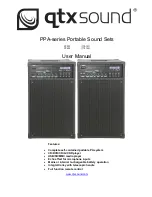
Manual-4
MQ 302 CONNECTION
Exactly
where
you install your MQ 302 into a sound
system significantly affects such things as hum, noise, system
headroom, compressor/limiter performance and other factors
influencing overall sound quality. Both
what
and
why
you are
equalizing determines
where
you install it. We’ll leave the
when
and
who
entirely up to you.
WHAT AND WHY
Since acoustic compensation and tone contouring are two
of the most common uses for equalization, here are a few
words on each.
ACOUSTIC COMPENSATION
Acoustic compensation is controlled nicely with a device
such as the MQ 302. The best way to “see” what room
acoustics are doing to your sound is to use a real time
analyzer. This test equipment lets you analyze the response of
the room and the sound system and is the only accurate means
available for setting an equalizer properly.
TONE CONTOURING
Contouring is accomplished mainly by ear. This you know
how to do. Be careful though, not to introduce too much boost
to the upper bass area (or the sub-bass area as in the last
warning). Be aware that the MQ 302 is capable of boosting
signals up to 12 dB (4 times as large!)—a level at which great
care should be taken to prevent seismic disturbances.
WHERE
For tone contouring, the equalizer may be used at any
point in the signal chain, such as insert loops in a mixer to
equalize a single instrument, sweeten a tape recording, etc.
When an equalizer is used for acoustical correction, the
equalizer should be one of the
last
pieces of gear in front of
the amplifiers and active crossovers. Any further up the line
may cause electrical mismatch with other line level equip-
ment. Here are a few
general
guidelines useful in deciding
exactly where to install the MQ 302 in the system. See Figure
1.
DOWNSTREAM OF THE COMPRESSOR
Since system EQ is aimed at the
acoustical
problems, it
should be installed
after
any compressor, which is designed to
operate on electrical program material. For one thing, the
equalizer slider settings will change with each new location,
which in turn affects the control voltage and threshold
responses of the compressor and renders it inconsistent.
Secondly, healthy amounts of boost often strains the dynamic
range of compressors and increases the danger of distortion
and/or overload.
UPSTREAM OF THE LIMITER
If a limiter is installed strictly to protect the drivers, then
install the limiter just before the power amplifiers. A good
limiter leaves the dynamics unchanged until the amplifier
reaches driver overload levels.
AFTER ANY SYSTEM GAIN
Here is a trap many fall into: mixer, compressor/limiter,
equalizer, active crossover and power amplifier–all with gain
controls, and all working
against
each other. The MQ 302 has
good low noise levels, but it
is
a line-level active component.
If you set the INPUT LEVEL control way down (to avoid
overdriving the compressor which is wrongly connected
after
it), then you must turn
up
the compressor, crossover and
amplifier controls to compensate; now you’ll blame the
equalizer for being too noisy. Whenever headroom allows,
try to take all the gain at the mixer, and run unity levels from
there on. This also gives better noise performance from the
mixer. Connect the MQ 302 before the amplifier or active
crossover. Take any required line gain before the MQ 302.
Avoid taking a lot of gain in the crossover or power amps as
this creates noise and hum problems. The MQ 302 operates at
unity gain around “8” on the INPUT LEVEL control when
sliders average to center (0 dB). You can test this with the EQ
BYPASS switch—adjust the INPUT LEVEL control so that
volume does not change when switching between ACTIVE
and BYPASS.
SEND/RECElVE LOOPS
Mixers, mixer/preamps and the like often provide send/
receive loops for additional effects or EQ, and the MQ 302
works well in this situation. Just be sure to keep input trim or
gain controls turned up as far as the mixer input headroom
will allow, to avoid taking excessive gain downstream and
creating noise problems. Remember to feed the MQ 302 with
roughly line level program (between -10 dBV and +4 dBu to
+20 dBu), and all should work fine.
Содержание MQ 302
Страница 9: ...Manual 9 VARIOUS XLR CABLE ASSEMBLIES ...




























